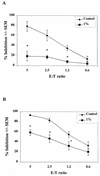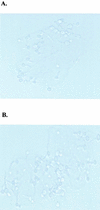Potential role for a carbohydrate moiety in anti-Candida activity of human oral epithelial cells
- PMID: 11598085
- PMCID: PMC100093
- DOI: 10.1128/IAI.69.11.7091-7099.2001
Potential role for a carbohydrate moiety in anti-Candida activity of human oral epithelial cells
Abstract
Candida albicans is both a commensal and a pathogen at the oral mucosa. Although an intricate network of host defense mechanisms are expected for protection against oropharyngeal candidiasis, anti-Candida host defense mechanisms at the oral mucosa are poorly understood. Our laboratory recently showed that primary epithelial cells from human oral mucosa, as well as an oral epithelial cell line, inhibit the growth of blastoconidia and/or hyphal phases of several Candida species in vitro with a requirement for cell contact and with no demonstrable role for soluble factors. In the present study, we show that oral epithelial cell-mediated anti-Candida activity is resistant to gamma-irradiation and is not mediated by phagocytosis, nitric oxide, hydrogen peroxide, and superoxide oxidative inhibitory pathways or by nonoxidative components such as soluble defensin and calprotectin peptides. In contrast, epithelial cell-mediated anti-Candida activity was sensitive to heat, paraformaldehyde fixation, and detergents, but these treatments were accompanied by a significant loss in epithelial cell viability. Treatments that removed existing membrane protein or lipid moieties in the presence or absence of protein synthesis inhibitors had no effect on epithelial cell inhibitory activity. In contrast, the epithelial cell-mediated anti-Candida activity was abrogated after treatment of the epithelial cells with periodic acid, suggesting a role for carbohydrates. Adherence of C. albicans to oral epithelial cells was unaffected, indicating that the carbohydrate moiety is exclusively associated with the growth inhibition activity. Subsequent studies that evaluated specific membrane carbohydrate moieties, however, showed no role for sulfated polysaccharides, sialic acid residues, or glucose- and mannose-containing carbohydrates. These results suggest that oral epithelial cell-mediated anti-Candida activity occurs exclusively with viable epithelial cells through contact with C. albicans by an as-yet-undefined carbohydrate moiety.
Figures







Similar articles
-
Vaginal and oral epithelial cell anti-Candida activity.Infect Immun. 2002 Dec;70(12):7081-8. doi: 10.1128/IAI.70.12.7081-7088.2002. Infect Immun. 2002. PMID: 12438389 Free PMC article.
-
Oral and vaginal epithelial cell anti-Candida activity is acid labile and does not require live epithelial cells.Oral Microbiol Immunol. 2005 Aug;20(4):199-205. doi: 10.1111/j.1399-302X.2005.00212.x. Oral Microbiol Immunol. 2005. PMID: 15943762 Free PMC article.
-
Potential role of high molecular weight hyaluronan in the anti-Candida activity of human oral epithelial cells.Med Mycol. 2007 Feb;45(1):73-9. doi: 10.1080/13693780601039607. Med Mycol. 2007. PMID: 17325947
-
Candida-host interactions in HIV disease: relationships in oropharyngeal candidiasis.Adv Dent Res. 2006 Apr 1;19(1):80-4. doi: 10.1177/154407370601900116. Adv Dent Res. 2006. PMID: 16672555 Review.
-
Innate Immunity and Saliva in Candida albicans-mediated Oral Diseases.J Dent Res. 2016 Apr;95(4):365-71. doi: 10.1177/0022034515625222. Epub 2016 Jan 8. J Dent Res. 2016. PMID: 26747422 Free PMC article. Review.
Cited by
-
Vaginal epithelial cell anti-Candida albicans activity is associated with protection against symptomatic vaginal candidiasis.Infect Immun. 2005 Nov;73(11):7765-7. doi: 10.1128/IAI.73.11.7765-7767.2005. Infect Immun. 2005. PMID: 16239581 Free PMC article.
-
Cervical mucins carry alpha(1,2)fucosylated glycans that partly protect from experimental vaginal candidiasis.Glycoconj J. 2009 Dec;26(9):1125-34. doi: 10.1007/s10719-009-9234-0. Glycoconj J. 2009. PMID: 19326211 Free PMC article.
-
Candida-host interactions in HIV disease: implications for oropharyngeal candidiasis.Adv Dent Res. 2011 Apr;23(1):45-9. doi: 10.1177/0022034511399284. Adv Dent Res. 2011. PMID: 21441480 Free PMC article. Review.
-
Annexin-A1 identified as the oral epithelial cell anti-Candida effector moiety.Mol Oral Microbiol. 2010 Aug;25(4):293-304. doi: 10.1111/j.2041-1014.2010.00579.x. Mol Oral Microbiol. 2010. PMID: 20618702 Free PMC article.
-
Beyond Candida albicans: Mechanisms of immunity to non-albicans Candida species.Cytokine. 2015 Nov;76(1):42-52. doi: 10.1016/j.cyto.2015.07.025. Epub 2015 Aug 11. Cytokine. 2015. PMID: 26276374 Free PMC article. Review.
References
-
- Brandtzaeg P, Gabrielsen T O, Dale I, Muller F, Steinbakk M, Fagerhol M K. The leucocyte protein L1 (calprotectin): a putative nonspecific defense factor at epithelial surfaces. Adv Exp Med Biol. 1995;371:201–206. - PubMed
-
- Cenci E, Mencacci A, Spaccapelo R, Tonnetti L, Mosci P, Enssle K H, Puccetti P, Romani L, Bistoni F. T helper cell type 1 (Th1)- and Th2-like responses are present in mice with gastric candidiasis but protective immunity is associated with Th1 development. J Infect Dis. 1995;171:1279–1288. - PubMed
-
- Cenci E, Romani L, Vecchiarelli A, Puccetti P, Bistoni F. T cell subsets and IFN-gamma production in resistance to systemic candidosis in immunized mice. J Immunol. 1990;144:4333–4339. - PubMed
Publication types
MeSH terms
Substances
Grants and funding
LinkOut - more resources
Full Text Sources

